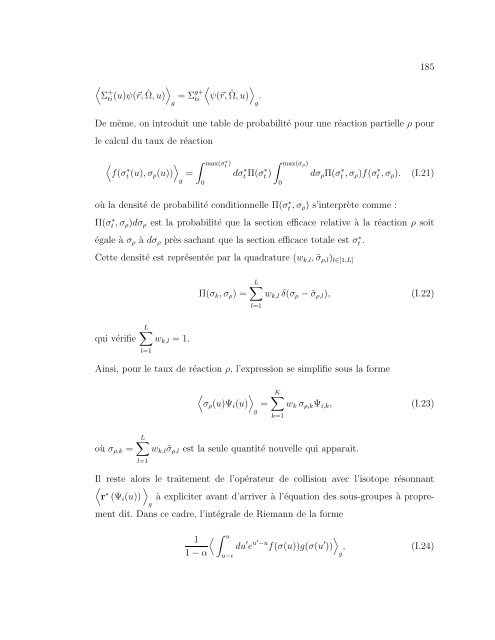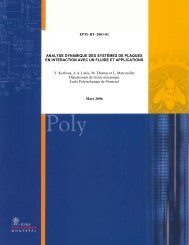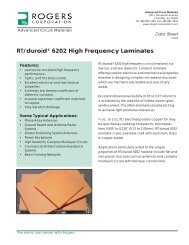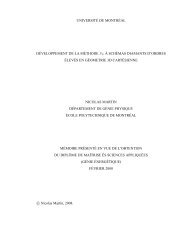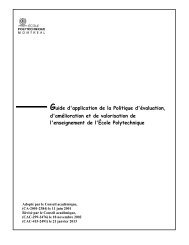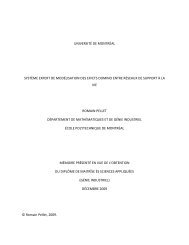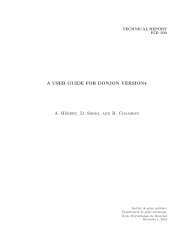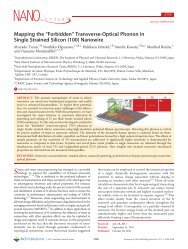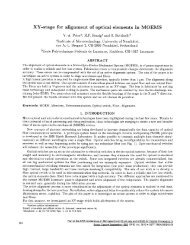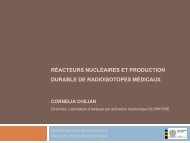- Page 1 and 2:
UNIVERSITÉ DE MONTRÉAL DÉVELOPPE
- Page 3 and 4:
iv À mes grand-parents, William et
- Page 5 and 6:
vi RÉSUMÉ Ce projet s’intéress
- Page 7 and 8:
viii ABSTRACT This project is dedic
- Page 9 and 10:
x TABLE DES MATIÈRES DÉDICACE . .
- Page 11 and 12:
xii 4.1.6 Traitement des conditions
- Page 13 and 14:
xiv 9.2.1 Étude paramétrique . .
- Page 15 and 16:
xvi Fig. 7.2 Les différentes discr
- Page 17 and 18:
xviii Tab. 8.3 Comparaison DRAGON -
- Page 19 and 20:
xx LISTE DES ANNEXES ANNEXE I CALCU
- Page 21 and 22:
xxii VII.2 Analyse spectrale direct
- Page 23 and 24:
2 La seconde étape est le calcul d
- Page 25 and 26:
4 de transport des neutrons dans de
- Page 27 and 28:
6 où • ⃗r est la variable d’
- Page 29 and 30:
8 Par ailleurs, on peut aussi effec
- Page 31 and 32:
10 1.3.4 Traitement de l’anisotro
- Page 33 and 34:
12 le Chapitre 3, on fait la revue
- Page 35 and 36:
14 2.1.1 La procédure de tracking
- Page 37 and 38:
16 initiale tan(ψ) = mb na . (2.2)
- Page 39 and 40:
18 introduit numériquement une dé
- Page 41 and 42:
20 et l’intégration des moments
- Page 43 and 44:
22 positif ssi. les sources q k (
- Page 45 and 46:
24 2. des conditions isotropes pour
- Page 47 and 48:
26 des différentes régions, • L
- Page 49 and 50:
28 Bien qu’un schéma de Jacobi c
- Page 51 and 52:
30 montré au § 2.4). Dans les aut
- Page 53 and 54:
32 nir remplacer avantageusement le
- Page 55 and 56:
34 Dans ces conditions, la matrice
- Page 57 and 58:
36 simplificatrice vis à vis de l
- Page 59 and 60:
38 Pour finir sur ces méthodes syn
- Page 61 and 62:
40 3.1.4 Contexte multigroupe Dans
- Page 63 and 64:
42 protection, les points de la qua
- Page 65 and 66:
44 1. Projection sur l’espace de
- Page 67 and 68:
46 3.2.4 Conclusion On a vu l’int
- Page 69 and 70:
48 Le point de départ pour la dér
- Page 71 and 72:
50 Avec les notations précédentes
- Page 73 and 74:
52 En substituant les Eqs. (4.15) e
- Page 75 and 76:
54 où • ˜∑s = I proj ∑ s I
- Page 77 and 78:
56 pour la frontière de sortie) po
- Page 79 and 80:
58 Dans le cas particulier de condi
- Page 81 and 82:
60 nous avons utilisé cette approc
- Page 83 and 84:
62 0.5 c=0.5 0.9 c=0.9 0.8 0.4 0.7
- Page 85 and 86:
64 1 c=0.5 1 c=0.9 0.8 0.8 Rayon sp
- Page 87 and 88:
66 4.3 Méthodologie de résolution
- Page 89 and 90:
68 Le critère de convergence est
- Page 91 and 92:
70 directement dues à la dégradat
- Page 93 and 94:
72 Two-step ACA. 7.5 7.34 ACA two
- Page 95 and 96:
74 mémoire; nous nous proposons do
- Page 97 and 98:
76 et la méthode SCR corrige alors
- Page 99 and 100:
78 combinaison des deux sont prése
- Page 101 and 102:
80 = ⎡ ⎢ ⎣ ⎡ ⎢ ⎣ D G fa
- Page 103 and 104:
82 avec un grand nombre de régions
- Page 105 and 106:
84 procédure très simple de type
- Page 107 and 108:
86 Algorithme 5.1 Méthode Generali
- Page 109 and 110:
88 à l’intérieur du solveur bas
- Page 111 and 112:
90 méthode des caractéristiques.
- Page 113 and 114:
92 GMRES préconditionnée par ACA
- Page 115 and 116:
94 CHAPITRE 6 CADRE DE DÉVELOPPEME
- Page 117 and 118:
96 concernant les différents modul
- Page 119 and 120:
98 dans l’assemblage. Dans chaque
- Page 121 and 122:
100 Cette étude a d’abord été
- Page 123 and 124:
102 du bore à une concentration de
- Page 125 and 126:
104 mois a été effectué. À la f
- Page 127 and 128:
106 la DRAGLIB requiert une condens
- Page 129 and 130:
108 taux d’absorption [Hébert, 2
- Page 131 and 132:
110 CHAPITRE 7 BENCHMARKS BWR On pr
- Page 133 and 134:
112 7.2 Le cas BASALA-H On se conce
- Page 135 and 136:
114 Ainsi, avec ces notations, la c
- Page 137 and 138:
116 On voit que 20 angles sont suff
- Page 139 and 140:
118 Les résultats sont présentés
- Page 141 and 142:
120 résonances non-résolues. On v
- Page 143 and 144:
122 résultats du cas BASALA-H, une
- Page 145 and 146:
124 Modèle ∆k eff ¯ǫ (ǫ max )
- Page 147 and 148:
126 0.432. Si la réduction est moi
- Page 149 and 150:
128 P 2 , on a aussi testé la comb
- Page 151 and 152:
130 2003]. Une librairie au format
- Page 153 and 154:
132 Fig. 8.1 Cellule CANDU NG discr
- Page 155 and 156: 134 teur combiné (corde et collisi
- Page 157 and 158: 136 0.012 0.01 Uranium Naturel, Dys
- Page 159 and 160: 138 avec les résultats en termes d
- Page 161 and 162: 140 très proches de celles du cas
- Page 163 and 164: 142 combinaison de GMRES et SCR qui
- Page 165 and 166: 144 ont été menés avec la premi
- Page 167 and 168: 146 condenser les sections efficace
- Page 169 and 170: 148 Zr; on a donc vingt mélanges r
- Page 171 and 172: 150 9.2.1 Étude paramétrique On d
- Page 173 and 174: 152 Ensuite, on a testé l’influe
- Page 175 and 176: 154 Conf. ∆k eff ¯ǫ (ǫ max ) (
- Page 177 and 178: 156 cédure d’équivalence dans c
- Page 179 and 180: 158 9.4 Temps de calcul et efficaci
- Page 181 and 182: 160 CONCLUSION Dans ce projet, on s
- Page 183 and 184: 162 mis la comparaison des différe
- Page 185 and 186: 164 Par ailleurs, ce projet a été
- Page 187 and 188: 166 [Bouras & Fraysse, 2000] Bouras
- Page 189 and 190: 168 [Hébert, 2005] Hébert, A. (20
- Page 191 and 192: 170 [Le Tellier & Hébert, 2006a] L
- Page 193 and 194: 172 [Marleau et al., 2006b] Marleau
- Page 195 and 196: 174 [Sanchez et al., 2002] Sanchez,
- Page 197 and 198: 176 [Suslov, 2001] Suslov, I. R. (2
- Page 199 and 200: 178 [X-5 Monte Carlo Team, 2003] X-
- Page 201 and 202: 180 pique auto-protégée est défi
- Page 203 and 204: 182 régulière Ξ(⃗r, u). Ensuit
- Page 205: 184 Pour les méthodes de sous-grou
- Page 209 and 210: 188 • (σ w,l , (W k,l ) k∈[1,K
- Page 211 and 212: 190 explicitement et résoudre le s
- Page 213 and 214: 192 sont limités à la diffusion i
- Page 215 and 216: 194 le cadre d’une quadrature pro
- Page 217 and 218: 196 II.1.2 Quadrature polaire D’a
- Page 219 and 220: 198 Ainsi, l’erreur d’évaluati
- Page 221 and 222: 200 0.6 0.5 0.4 |E 3 (τ j )−E 3
- Page 223 and 224: 202 N ∑ p sur le domaine ]0, 1[ 2
- Page 225 and 226: 204 w µ i η i w µ i η i OP 0 0.
- Page 227 and 228: 206 3 x 10−3 τ 2.5 OP 0 (3) : ma
- Page 229 and 230: 208 génère une telle quadrature a
- Page 231 and 232: 210 les quadratures OP L au sein du
- Page 233 and 234: 212 Une telle tentative a été ré
- Page 235 and 236: 214 [Suslov, 1997], ce schéma peut
- Page 237 and 238: 216 un tel schéma requiert le stoc
- Page 239 and 240: 218 - sinon, on ne peut dériver un
- Page 241 and 242: 220 régions par α permet de rédu
- Page 243 and 244: 222 En ce qui concerne le schéma S
- Page 245 and 246: 224 Flux mix 1 16 × 16 32 × 32 64
- Page 247 and 248: 226 observé dans le cas précéden
- Page 249 and 250: 228 blanches aux frontières et un
- Page 251 and 252: 230 ANNEXE IV STRATÉGIES D’INTÉ
- Page 253 and 254: 232 dans cette formulation, les coe
- Page 255 and 256: 234 est simplifié par l’absence
- Page 257 and 258:
236 où l’erreur introduite sur l
- Page 259 and 260:
238 ANNEXE V DÉVELOPPEMENTS DE TAY
- Page 261 and 262:
240 ANNEXE VI LES MÉTHODES DE KRYL
- Page 263 and 264:
242 Ce processus peut être résum
- Page 265 and 266:
244 Conjugué (CG). La formulation
- Page 267 and 268:
246 Comme V m+1 est orthonormale, p
- Page 269 and 270:
248 Alors, y m correspond à un min
- Page 271 and 272:
250 Algorithme VI.3 Algorithme Bi-L
- Page 273 and 274:
252 Par ailleurs, à partir de Bi-L
- Page 275 and 276:
254 présente dans ce cadre la mét
- Page 277 and 278:
256 ANNEXE VII ANALYSE SPECTRALE PO
- Page 279 and 280:
258 Après remplacement dans les Eq
- Page 281 and 282:
260 VII.1.3 Itérations préconditi
- Page 283 and 284:
262 dont les inconnues sont [ ( )
- Page 285 and 286:
264 i ∈ [1, N] et de Ψ out s = V
- Page 287 and 288:
266 vecteur C A . Par exemple, la m
- Page 289 and 290:
268 Algorithme VIII.1 Décompositio
- Page 291 and 292:
270 est réduit de G × (N C + N)
- Page 293 and 294:
272 Algorithme VIII.3 Nœud Pseudo-
- Page 295 and 296:
274 ANNEXE IX BENCHMARKS 2D MONO-É
- Page 297:
276 matériel Σ t Σ 0 s Σ 1 s ν


